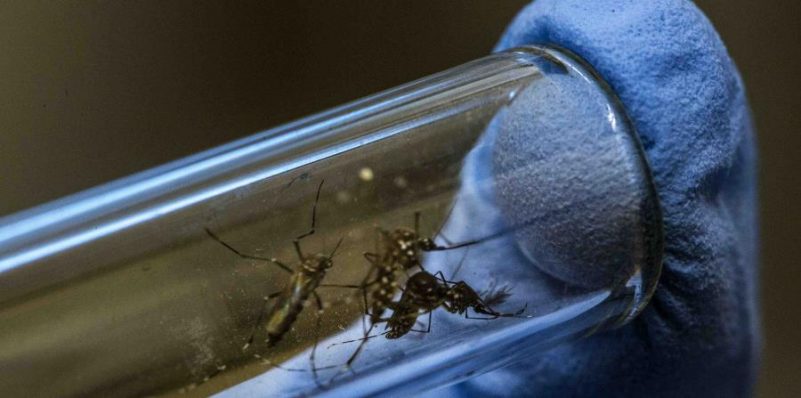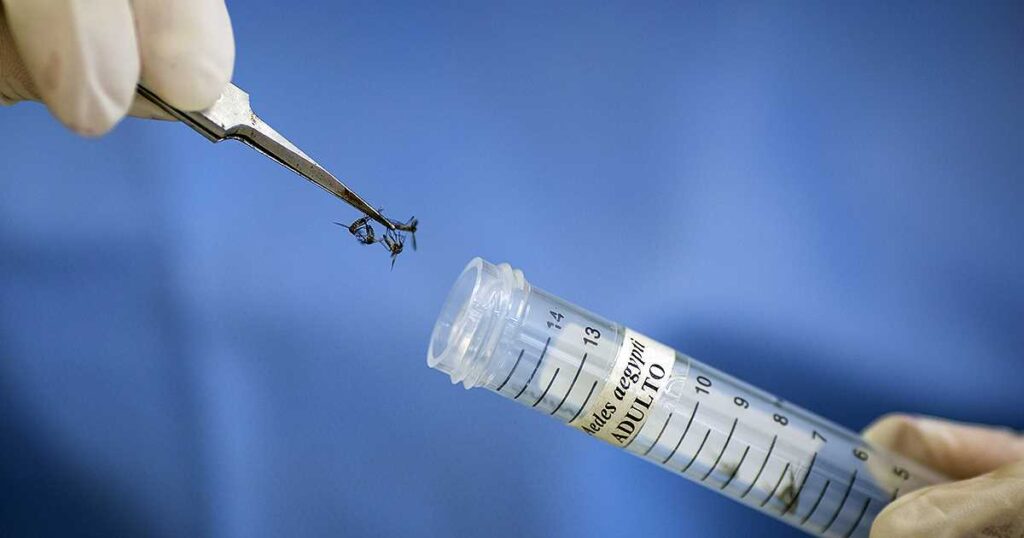The use of transgenic mosquitoes, genetically modified, to put an end to diseases such as malaria or dengue fever, does not give conclusive results. Yet millions of dollars are being invested in technology whose effects on biodiversity and ecosystems are unknown. What is the motive?
In April 2022, researchers from the British biotechnology company Oxitec claimed to have concluded in the Florida Keys, in the United States, the first outdoor study with genetically modified mosquitoes of the species. Aedes aegypti, produced by this company.
Five million of these mosquitoes were released into these keys for almost eight months, with the main purpose of observing how the natural populations of the Aedes aegypti, transmission agent of dengue, zika, yellow fever and chikungunya virus.
By design of Oxitec’s technology, the engineered males carry a lethal gene (OX5034) which, when released into the environment and after mating with wild females, causes their female offspring to die before ‘she cannot achieve her ability to reproduce, while the male will continue to carry the gene and continue to pass it on. Based on these preliminary results, which the company described as positive, they hope to carry out more tests and obtain more permits to continue demonstrating the effectiveness and safety of their method.
Contents
Context of the release of transgenic mosquitoes
Almost three years earlier, in August 2019, the Gorgas Memorial Institute for Health Studies, a Panamanian research institution under American control until 1990, claimed that by releasing more than 4 million Oxitec mosquitoes (OX513A), between May and November 2014 in the town of Nuevo Chorrillo, had succeeded in reducing the natural population of the Aedes aegypti by 93%. Despite the optimistic reports of the scientists of the Institute on the results obtained and the cost of the study carried out (more than 700,000 dollars), no evidence was found that in Panama the use of this technique is considered in the national strategy for the control of dengue fever and other diseases transmitted by Aedes aegypti.
recent comments
A recent review of Panama’s Ministry of Health website shows nowhere that the behavior of genetically modified mosquitoes has ever been evaluated, whereas at the Gorgas Institute all information has been removed or disabled, so one does not unclear if they then monitored the areas where these insects were released, in case there were females with the introduced gene reproducing freely; and, what would be worse: capable of producing dengue fever. The great enthusiasm and optimism that this technology aroused among some Panamanian scientists in 2014 has gradually dissipated like soap bubbles.
Between 2013 and 2015, a test similar to the one developed in Panama had already been carried out in Juazeiro, a Brazilian town in the state of Bahia. There, a 90% reduction in the mosquito population was reported. bards, which then increased significantly again a year and a half after the trial; Noting, moreover, not only that the genetic modification had been transferred to the mosquitoes of the wild population, but that the test itself had produced no effect on dengue fever as a disease. Despite this, in 2020 the Brazilian Biosafety Authority approved the commercial use of transgenic mosquitoes throughout Brazilian territory. Today, Oxitec claims to have released more than one billion GM mosquitoes around the world, including the Cayman Islands, Malaysia, four counties in California, Mexico’s Yucatan and other countries.
The effectiveness of transgenic mosquitoes has not been proven
The truth is that in all places and countries where tests have been carried out to control the natural populations of the Aedes aegypti, Based on the release of genetically modified mosquitoes, it has not been possible to demonstrate that this method is as effective and safe as its creators had promised. The flaws in the technology found show that nothing prevents the modified mosquitoes from being able to interbreed with other species such as the Aedes albopictus (which is more invasive and deadly than the species Egyptian), are later more resistant to insecticides or have a greater ability to cause more serious diseases.
Already in 2018 in the article “Dengue fever and the transgenic lie”, referring to the main problems of the method of the company Oxitec to combat Aedes aegypti, I expressed the following:
“So far, there is no doubt that one of the big problems with Oxitec’s technology, and any other similar technology, is that due to the serious shortcomings, insecurities and risks it entails, mosquitoes modified end up genetically imposing themselves on nature. , with all the uncertainties and unknown environmental impacts that this represents. This situation, possible in the real world, is based on the fact that the RIDL technique uses in the laboratory a method of separating by size the pupal stage of transgenic males and females, which is so inefficient that for every half million male transgenic mosquitoes produced, filtered and released, with them, at best, more than 100 females”.
The relationship with the antibiotic tetracycline

Later, when describing this technique and its relationship to the antibiotic tetracycline, I said:
“Another important problem that characterizes the technology of transgenic mosquitoes is its dependence on an antibiotic so common in the environment as tetracycline; It is widely used in human medicine, veterinary medicine and industrial agriculture, and for this reason it is usually found in municipal waste, fast food, soil, sewage and food for cats and dogs, among others. . This drug, which in the Oxitec laboratory is used to raise transgenic mosquitoes until their adult phase, if the offspring is not available later, assure the creators of the technology, condemns them to die in a programmed way.
However, at the same time they admit that under controlled laboratory conditions they observed that up to 3% of mosquitoes survived without tetracycline, and between 15 and 18% also did, when encountered this antibiotic both in natural environments As some food. That is why it is easy to deduce that this survival rate will be much higher if, to the transgenic mosquitoes that can survive without the antibiotic, they are joined by those that are released in areas where tetracycline is listed as significant industrial pollutant. “.
Technological gaps and ethical issues
Because of these obvious shortcomings in Oxitec’s transgenic mosquito technology since its inception, and the ongoing questions its releases into the environment have raised everywhere, biotech companies have begun to believe that the answer to all One of these problems lies in the use of gene drives.
Already in 2015, thanks to the CRISPR/Cas9 tool, female mosquitoes of the genus anopheles gambiae that transmit malaria, by inserting genes that stop the growth of the blood parasite of the genus Plasmodium, responsible for this disease. Three years later, scientists at Imperial College London reported in the journal Nature Biotechnology that, using gene drives, they had created a genetic mutation that rendered female mosquitoes sterile. anophelesand that in just eleven generations they succeeded in eliminating for the first time an entire isolated population of this insect.
Thus, a technology designed to exterminate entire populations of living things seems more commercially attractive for controlling mosquitoes that cause disease in humans. But this time, it is no longer just a question of regulating them over time, but of quickly and definitively extinguishing them as a species, regardless of the biosecurity risks and the ecological consequences for ecosystems. The lack of ethics of the defenders of this method is of such magnitude that they dare to assure that “It is one of the most biodiversity friendly for mosquito control”.
Conclusions on transgenic mosquitoes
We already know that enthusiasts of such technologies and those with a strong interest in commercializing them for the enormous economic benefits expected tend to ignore or downplay the concerns they raise, as well as the potential risks and impacts they bring. generate. Transgenic mosquito technology seems destined to create more problems than solutions in the ecosystems concerned. Therefore, there is no doubt that it poses a real threat to the whole environment, to human health, food safety and wildlife.
ecoportail.net
Character font
